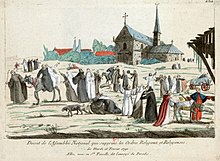Popes during the Age of Revolution
[1]: 97 Four years later, when Napoleon reached as far south as Ancona in an advance on Rome, this incident remained a specific grievance for which France held the pope responsible - demanding and receiving 300,000 livres as compensation for Basseville's family.
The price of persuading the French intruder to head north again, agreed in the Treaty of Tolentino, was a massive indemnity, the removal of many works of art from the Vatican collections and the surrender to France of Bologna, Ferrara and the Romagna.
He negotiated the French Concordat of 1801 which reaffirmed the Roman Catholic Church as the major religion of France and restored some of its civil status, removing it from the authority of the Pope.
[7] Claims that he seized the crown out of the hands of Pope Pius VII during the ceremony in order to avoid subjecting himself to the authority of the pontiff are apocryphal; in fact, the coronation procedure had been agreed upon in advance.
[8] Pius VII was soon thereafter arrested by French General Etienne Radet, acting on letters from Napoleon to his commanders in Italy ambiguously expressing consternation over the Pope's recalcitrance.
Louis Napoleon Bonaparte, recently elected president of the newly declared French Second Republic, saw an opportunity to assuage conservative Catholic opinion in France, and in cooperation with Austria sent troops to restore Papal rule in Rome.
After some hard fighting, Pius was returned to Rome by a victorious French army, and repenting of his previous liberal tendencies pursued a harsh, conservative policy even more repressive than that of his predecessors.
Seven months later, on 18 July 1870, the prelates assembled in St Peter's accepted an uncompromising dogma - that the pope, when speaking from his throne on a matter of faith or morals, is inspired by God and is therefore infallible.
